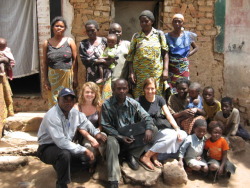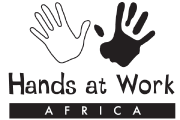The community of Kikula is located on the outskirts of the city of Likasi in the DRC. It is one of the poorest communities in the city and is composed of makeshift shantytowns and brick huts.
The streets in any part of Kikula are lined with mothers and babies, storefronts, buckets of maize and bundles of charcoal for sale. There are countless children wandering around; as far as the eye can see. The roads of the community are damaged beyond belief and only the bravest of drivers venture out into the sometimes impassable terrain.
 Kashama sits on a rock in front of his house. He has a sandal with a broken strap in his hands and he appears to be mending the dusty and worn leather. Beside him is a pile of footwear that tells a similar story of misfortune. This is Kashama’s “business” and his source of income. As Kashama stands up to greet the care workers, the limp in his step and deformity in his appearance becomes apparent. He moves slowly and with care as he greets his friends. Later, Kashama shares in conversation, that he was born with the deformity that appears to be a form of polio and has lived with it his entire life.
Kashama sits on a rock in front of his house. He has a sandal with a broken strap in his hands and he appears to be mending the dusty and worn leather. Beside him is a pile of footwear that tells a similar story of misfortune. This is Kashama’s “business” and his source of income. As Kashama stands up to greet the care workers, the limp in his step and deformity in his appearance becomes apparent. He moves slowly and with care as he greets his friends. Later, Kashama shares in conversation, that he was born with the deformity that appears to be a form of polio and has lived with it his entire life.
In front of Kashama’s brick house stands his wife, Mujinga, surrounded by a cluster of children that are milling around. Some playing, some crying, all coated in a thin layer of road dust. From a distance Mujinga is a typical Congolese woman taking care of her children and tending to the tasks of life and home. However, when taking a closer look at Mujinga’s circle of life, one quickly realizes that she moves with the guarded hesitancy of a blind person. Though Mujinga cannot see, she still has an infant in her arms and two more toddling at her feet. She is the mother of eleven children, including one set of twins and one set of two-year -old triplets. Mujinga laughs as her husband Kashama leads the care workers to her one by one; she warmly greets each one in the traditional Swahili greeting.
surrounded by a cluster of children that are milling around. Some playing, some crying, all coated in a thin layer of road dust. From a distance Mujinga is a typical Congolese woman taking care of her children and tending to the tasks of life and home. However, when taking a closer look at Mujinga’s circle of life, one quickly realizes that she moves with the guarded hesitancy of a blind person. Though Mujinga cannot see, she still has an infant in her arms and two more toddling at her feet. She is the mother of eleven children, including one set of twins and one set of two-year -old triplets. Mujinga laughs as her husband Kashama leads the care workers to her one by one; she warmly greets each one in the traditional Swahili greeting.
Out of their eleven children, only four are currently attending school because school fees are expensive. The older children were removed from primary school several years ago to allow for the younger children to attend. The oldest child in the family is Gracia, who is eighteen years old and has achieved a grade four education. Gracia supplements his father’s shoe repairing income by carrying heavy loads of wood and charcoal on his bike for charge. Even with both sources of income, there is often not enough money to provide the thirteen-member family with one meal of maize each day. Some days the family does not eat.

This family is doing the best they can with what they have and what they know. Yet it isn’t enough. Even so, the care workers visit this family once each week to encourage and pray with them, providing them with hope from the bible and meeting small needs when they can. This hope and encouragement carries this family of thirteen from one week to the next, hoping that one day their basic needs will be met.
